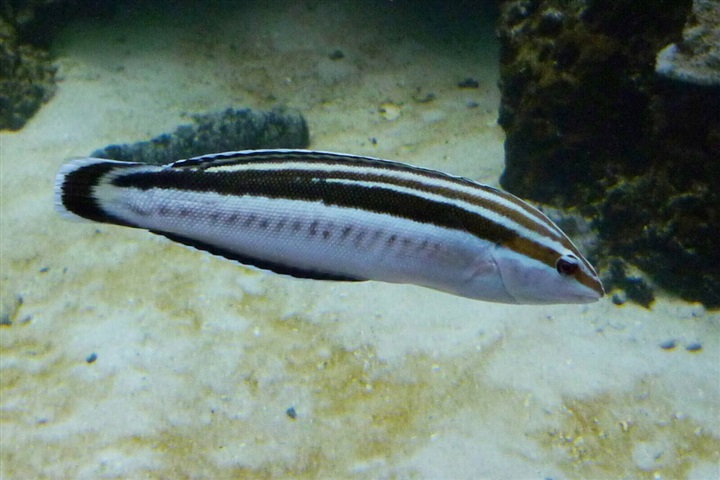Coris flavovittata

| Latin name | Coris flavovittata - (Bennett, 1828) |
|---|---|
| Local name | Yellowstripe coris |
| Family | Labridae - Coris |
| Origin | Japan, Central/West Pacific |
| Max length | 51 cm (20.1") |
| Minimum volume |
1500 l (396 gal) |
|---|---|
| Hardiness |
Hardy |
| Suitable for aquarium |
Suitable with care |
| Reef safe |
Not reef safe |
| Aggressiveness | Might be aggressive towards other species |
| Recommended |
Larger crustaceans (Shrimp, crabs...) Other invertebrates Small crustaceans (Krill, mysis, artemia...) |
|---|---|
| Maybee |
Fish |
This spicies might be a threat to smaller fishes.
This species sometimes nibbles at clams including Tridacna species.
These fish will hunt crustaceans, sea urchins and worms in an aquarium, very effectively.
This species needs a very large aquarium when fully grown.
Exactly how big the aquarium should be is hard to say, but the size of this species is such, that it cannot normally be kept in a home aquarium.
This species must be fed with an appropriately varied diet.
This species needs a minimum of 2 inch (5 cm) of sand in the aquarium bottom, so it can dig itself down when afraid or needing to sleep.
This species will better acclimatize to the aquarium`s condition if introduced, when young.
Very small individuals can be very delicate.
This species has a habit of rearranging rocks and sand.
Make sure rocks are placed securely on the substrate, so they cannot toppled over.
These fish may well hide themselves for a while, whilst getting acclimatized.
Do not disturb the fish while acclimating because it will prolong the process.
This species revels in swimming and requires an aquarium with ample space.
This species can change gender from female to male.
When a male is needed, a female changes sex and takes on the role.
This species can be used to combat Pyramid snails.
One can of course be unlucky in having an individual that refuses to eat them.
Rainbow Wrasses (Coris) grow to a large size and their appearance changes markedly from juvenile to adult.
They dig themselves into the substrate of the tank to sleep or when threatened, so it is necessary to have an appropriate depth of substrate.
2-4 inch (5-10 cm) depending on their size.
One is often tempted to buy them as they are seen as small fish in the store, but they quickly end up being discarded or sold on, as they outgrow most domestic aquaria. When large they are a threat to bivalves, sea urchins, starfish and large crustaceans. When small, they eat Mysis, Artemia or similar foods. The larger ones will also eat small fish if given the chance, so be aware when having small, slow swimming fish.
When the fish get bigger they begin looking for food beneath loose objects which can be very destructive in a reef aquarium if this natural behaviour is not taken into account.
When selecting them, pay particular attention to the area around the mouth to make sure they have not been injured during transit. They must have the opportunity to dig themselves in, even during transportation.
When first introduced they can remain buried in for several days, but will soon appear if not stressed by other fish or the aquarist.
Wrasses are nearly always seen in reef aquaria, since many of the species are both attractive and useful in battling a range of unwanted invertebrates like i.e. flatworms, pyramide snails.
These fish live of everything from zooplankton to large crustaceans, sea urchins and the like.
The needs and behaviour of Wrasses vary greatly, so it is vital to familiarize oneself with the specific species before buying one.
| Aquarium trade | Yes |
|---|---|
| Distribution | Eastern Central Pacific: Hawaiian Islands (Ref. 3921). Northwest Pacific: Midway Islands (Ref. 33411). |
| Danish common names |
Sortbåndet læbefisk |
| English common names |
Yellowstripe coris |
Henry C. Schultz. 2005. Everybody Sing Together!: The Genus Coris - Reefkeeping Magazine - (English)
Bob Fenner. Wrasses of the Genus Coris - Wet Web Media - (English)
Scott W. Michael. 2009. Wrasses and Parrotfishes (Reef Fishes Series Book 5) - TFH Publications / Microcosm Ltd. - (English)

